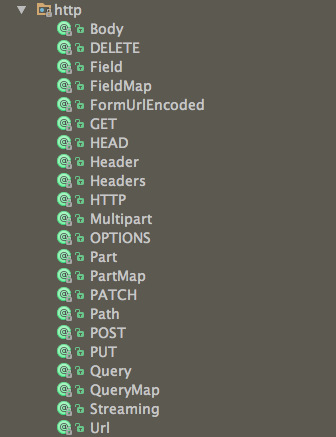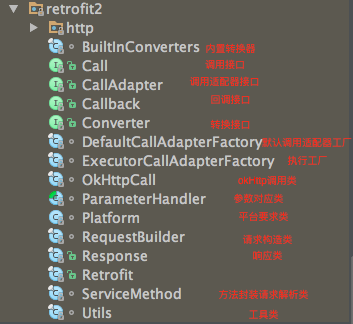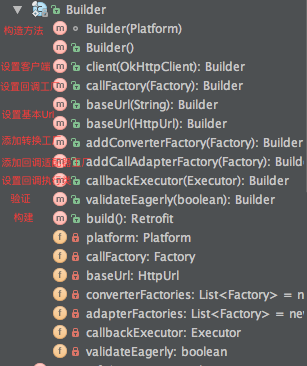简介:
Retrofit 是Square公司推出的一个类型安全的Http的适应于Android,java客户端的框架
下载:
Gradle: compile ‘com.squareup.retrofit2:retrofit:2.1.0’
要求 java7, Android2.3以上
官网:http://square.github.io/retrofit/
使用:
申明一个API接口
1234public interface GitHubService {("users/{user}/repos")Call<List<Repo>>listRepos(("user") String user);}使用Retrofit类实现这个接口
1234Retrofit retrofit = new Retrofit.Builder().baseUrl("https://api.github.com/").build();GitHubService service = retrofit.create(GitHubService.class);同步或异步向服务器发送http请求
123456789Call<List<Repo>> repos = service.listRepos("octocat");repos.enqueue(new Callback<List<Repo>>){public void onResponse(Response<List<Repo>> response,Retrofit retrofit){}public void onFailure(Throwable t){}}
使用注解描述请求
- 支持URL参数和请求参数
- 请求实体对象转换
- 多种请求实体和文件上传
代码结构
其中http包为各种注解


Body
用来指定POST或PUT请求里以实体形式发送的请求方法的参数,对象将会被序列化并放在请求body中DELETE
用来指定一个删除请求Field
用来指定form-encoded请求的指定键值参数,支持多个多个字符串指定FieldMap
用来指定form-encoded请求的未指定键值对参数FormUrlEncoded
用来指定一个Url被加密,使请求带有application/x-www-form-urlencoded MIME 类型
键值对将会由之前的UTF-8编码RFC-3986GET
用来指定一个GET请求HEAD
用来指定一个HEAD请求Header
用来指定请求头部参数,如果有重复,不会被重写,会被同时包含在头文件里Headers
用来指定头部键值对信息HTTP
用来指定HTTP形式请求Multipart
表示请求实体为多个,每部分使用@Part注解在参数中声明OPTIONS
用来指定一个OPTIOINS请求Part
用来指定含有多个部分请求的一个部分PartMap
表示键值对部分PATCH
用来指定一个PATCH请求Path
用来在参数中指定url被替换的部分POST
用来指定一个POST请求PUT
用来指定一个PUT请求Query
用来指定Url路径的查询键值对参数QueryMap
用来指定Url路径的查询键值对Streaming
用来指定Response body为字节数组形式返回URL
用来指定完整路径
原理分析
首先先构建一个Retrofit对象,从构建方式可以看出,使用的是设计模式中的Builder模式,Builder模式用于构建复杂的对象,并将构建过程和它的部件解耦,使用户在不知道内部构建细节的情况下精细的控制对象的构建流程。
最后在build方法中设置相关参数,如果未设置callFactory会构造默认的okHttpClient对象,其余的则默认构造Platform类的默认方法获取相关对象,然后将相关参数通过Retrofit类的构造方法构造出Retrofit对象

通过Retrofit类的create方法,返回一个动态代理的对象,这里涉及到涉及模式中的代理模式,也称为委托模式,相关代码如下:
首先调用工具类方法validateServiceInterface()验证接口,这里将会验证传进来的类是否是接口类型,如果不是则报出“API申明必须是接口”的无效参数异常,如果是接口,则继续检查该类是否实现了其它接口,如果是,则报出“API 接口不能是其它接口延伸的”的无效参数异常
|
|
然后通过eagerlyValidateMethods()方法的loadServiceMethod()方法生成serviceMethod对象并一起存入缓存map中,通过platform这个类进行平台判断,对java8 特性 default method 方法做了兼容处理,这里做了个同步锁,防止多线程下重复put ServiceMethod对象。
当执行阶段时,okHttpCall 会调用enqueue()方法,内部调用createRawCall() 方法生成okhttp3.Call对象,通过ServiceMethod实例的toRequest()方法将相关信息由RequestBuilder类构建成Request类请求并通过okHttpCall真正调用okhttp3发送请求。